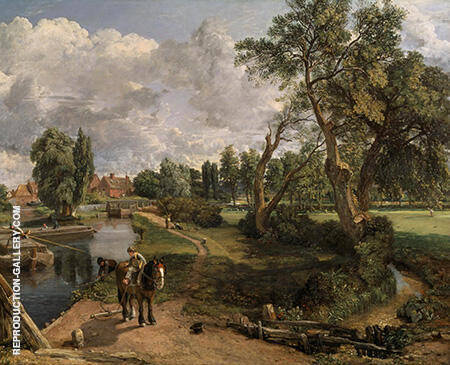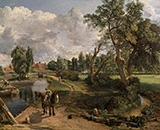Flatford Mill 1817 By John Constable
John Constable Flatford Mill presents a fascinating glimpse into English society in the early nineteenth century.
Constable's oil painting is also one of the English countryside's most famous landscape oil paintings.
Green fields and ancient oak trees appear on the right-hand side of the image. However, to the left of the painting, the effects of the Industrial Age are apparent. Men work alongside horses on a canal towpath, and large red-brick buildings are visible in the distance.
Where is the location of Flatford Mill, and when was it painted?
John Constable painted Flatford Mill between 1816 and 1817. He displayed the work at the Royal Academy in 1817.
Amongst paintings by John Constable, it’s unusual for its generous size. At over 100 by 120 centimeters, it was his largest canvas painted outdoors.
Before this date, Constable produced “exhibition works” in his studio. Around 1814 however, Constable declared he would create finished paintings purely from nature.
In Flatford Mill (subtitled “Scene on a Navigable River”), Constable depicts scenes from his childhood in Suffolk. Describing his early years as “careless boyhood”, Constable loved painting scenes of the River Stour. Indeed, the nearby “Willy Lott’s House” also appears in another famous painting by John Constable, The Hay Wain (1821).
The painting shows young boys disconnecting a rope from a horse. This technique enabled boats to cross under Flatford Bridge, where bargemen would push the barge through themselves.
Despite the highly detailed outdoor scene, Constable finished many elements in his studio. This later work includes details such as the timberwork, the boy and the horse, and the mooring post.
Flatford Mill is just south of the village of East Bergholt. Found on the east side of Dedham Vale (an Area of Outstanding Natural Beauty), it is a stunning location.
The Tate Gallery (in London, England) currently owns Flatford Mill by John Constable. Bequeathed by Miss Isabel Constable (John Constable’s daughter), it passed into the museum’s collection in 1888.
It forms part of a diverse collection of paintings by John Constable at the Tate Galleries. With over 256 individual artworks, this includes oil painted landscapes such as Salisbury Cathedral from the Meadows and Dedham Vale, as well as many beautiful cloud studies.
How much is Constable's famous landscape oil painting worth?
In 1986, a collector bought Flatford Mill for just over $3.7 million. At the time, this was almost eight times the earlier record sale price for nineteenth-century English art.
Sold at Christie’s auction house, it’s remained in Britain. With inflation, this is equivalent to $9 million today.
An earlier record for John Constable's paintings emerged in 1985 when a collector paid almost half a million dollars. For this price, they bought an oil-on-paper composition depicting a sunset in Hampstead, North London.
What happened to Constable's painting of Flatford?
Flatford Mill helped “full” cloth. “Fulling” was a process of beating woolen cloth (while still wet) to make the fibers interloc. As a result, it created more robust, durable textiles.
Known as Flotfordmelle for much of its early history, the site was a working mill for several centuries.
From 1742 to 1846, the Constable family owned the plot. Abram Constable bought the mill in 1742, where he employed two millers, named Henry Crush and Samuel Lamb.
Golding Constable (John Constable’s father) inherited the mill in 1768. He continued operating the mill and ran a fleet of commercial barges along the River Stour. In 1816 Abram Constable Junior (John Constable’s younger brother) took over Flatford Mill when his father died.
Flatford Mill is an ancient site. The Domesday Book of 1087 mentions a well-established mill on the land. This description is the first historical record of the mill.
It even records William the Conqueror’s order to keep some of this rich pasture land for himself and that there was a mill at Flatford even before the Norman Conquest in1066.
Constable was never financially successful in his own life. However, today, his paintings are among the most sought-after oil painting reproductions. John Constable's art reproductions remain some of our most desirable and beautiful landscape oil paintings.
In a fitting tribute to a painter who revolutionized landscape painting, the area around East Bergholt now prides itself as “Constable Country”.
We offer a 100% money back guarantee or replacement service. If for any reason you are dissatisfied with your painting please contact us within 7 days of receipt, advising the reason you are unhappy and we will provide you with all the information you need for its return or replacement.
We ship free to anywhere in the world via FedEx or DHL expedited service with online tracking.
Your painting will be shipped rolled in strong plastic tubing, ready for stretching and/or framing locally. This is the conventional method of transporting hand-painted oil on canvas. Learn more about how your painting is shipped.
We are able to offer a framing service intercontinental U.S. Please contact us if you would like a quotation. Alternatively, should you prefer, we can recommend a framer in your area.
Notes About Your Painting
Please note that replica oil paintings are finished with an additional 10cm (4") of extra canvas on all sides, allowing ample surplus canvas for stretching and framing.
Recently Viewed:
Cannot Find What You Are Looking For?
Reproduction Gallery Information
Customer Service
(Send Us A Message)
Tel: (503) 937 2010
Fax: (503) 937 2011







